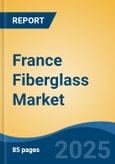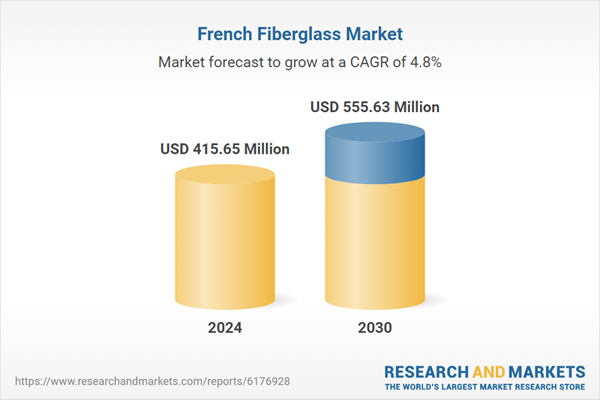Speak directly to the analyst to clarify any post sales queries you may have.
10% Free customizationThis report comes with 10% free customization, enabling you to add data that meets your specific business needs.
Key Market Drivers
Growing Demand for Lightweight and Sustainable Materials in Automotive Manufacturing
One significant driver for the fiberglass market in France is the increasing demand for lightweight and sustainable materials in various industries, particularly the automotive sector. Fiberglass composites offer an excellent solution to meet these requirements, as they are strong, lightweight, and can be tailored to meet specific performance and design criteria. As the automotive industry strives to reduce emissions and improve fuel efficiency, automakers are turning to fiberglass composites to replace traditional metal components.Fiberglass-reinforced plastics are being used in various automotive applications, such as body panels, chassis components, and interior parts. This trend is driven by the need to reduce vehicle weight, which, in turn, leads to lower fuel consumption and reduced carbon emissions. Furthermore, fiberglass composites are corrosion-resistant, which prolongs the lifespan of automotive parts and reduces maintenance costs.
Sustainability concerns are driving the adoption of fiberglass in the automotive industry. Fiberglass materials are recyclable and have a lower environmental footprint compared to some traditional materials. As governments and consumers demand greener solutions, the use of fiberglass composites is expected to grow, making it a major driver for the fiberglass market in France.
Key Market Challenges
Intense Competition in a Mature Market
One of the significant challenges facing the fiberglass market in France is the intense competition within the industry. The market for fiberglass and fiberglass-reinforced composites is relatively mature and well-established, with numerous domestic and international manufacturers vying for market share. This high level of competition puts pressure on companies to differentiate themselves through innovation, quality, and cost-effectiveness.The mature nature of the market means that companies face difficulties in maintaining profit margins and sustaining growth. Price wars can erupt among manufacturers, particularly in commoditized segments of the market, where fiberglass products are viewed as interchangeable. This intense competition can lead to margin erosion and financial stress for some companies, making it challenging for them to invest in research and development or adopt more sustainable manufacturing processes.
Moreover, competition is not limited to traditional fiberglass producers. Emerging materials like carbon fiber and advanced plastics are increasingly seen as viable alternatives in certain applications, posing a threat to the fiberglass market. To overcome this challenge, fiberglass manufacturers in France must focus on innovation, diversification, and the development of high-value, specialty products to remain competitive in an ever-evolving market.
Key Market Trends
Increasing Adoption of Advanced Composite Materials for Sustainable Solutions
One notable trend in the France fiberglass market is the growing adoption of advanced composite materials, which offer more sustainable solutions across various industries. As sustainability becomes a top priority for consumers, businesses, and governments, there is a heightened demand for materials that can help reduce environmental impact while maintaining performance and durability. Advanced composites, including fiberglass composites, are increasingly favored for their ability to meet these requirements. More than 90% of recreational boats manufactured globally use fiberglass hulls due to their strength-to-weight ratio, low maintenance, and seawater corrosion resistance.Fiberglass composites are known for their lightweight yet strong properties, which make them a compelling choice for applications where weight reduction is essential, such as in the automotive and aerospace sectors. These materials can contribute to improved fuel efficiency, reduced greenhouse gas emissions, and enhanced overall energy performance. Moreover, fiberglass is corrosion-resistant, extending the lifespan of products and reducing the need for maintenance and replacement, further aligning with sustainability goals.
In addition to these benefits, the adoption of recyclable and bio-based resins in fiberglass manufacturing is on the rise, making composite materials even more eco-friendly. Manufacturers in the France fiberglass market are increasingly focusing on product design and engineering to enhance the sustainability of their offerings, and this trend is expected to continue as environmental concerns and regulations become more stringent. Fiberglass rebar is now used in over 500+ infrastructure projects annually worldwide due to its non-conductive nature, ideal for MRI rooms, power plants, and coastal buildings.
The construction industry is another sector where advanced composites, including fiberglass, are gaining prominence due to their sustainability advantages. Fiberglass-reinforced plastics are used in architectural applications like cladding, roofing, and insulation, helping to create energy-efficient and environmentally friendly buildings.
As France pushes for sustainability in manufacturing and construction, the adoption of advanced composite materials like fiberglass is expected to be a prominent trend in the market, driving innovation and creating new opportunities for growth.
Key Market Players
- BLG Fiberglass Manufacturing
- Glass Fibre Europe
- Ownes Corning
- 3B - the Fiberglass Company
- NOV, Inc.
- Chomarat Group
- Exel Composites Plc
- BGF Industries
Report Scope:
In this report, the France Fiberglass Market has been segmented into the following categories, in addition to the industry trends which have also been detailed below:France Fiberglass Market, By Glass Type:
- A-Glass
- C-Glass
- D- Glass
- E-Glass
- S-Glass
- Others
France Fiberglass Market, By Product Type:
- Glass Wool
- Direct & Assembled Roving
- Yarn
- Chopped Strand
France Fiberglass Market, By Application:
- Construction & Infrastructure
- Automotive
- Wind Energy
- Others
France Fiberglass Market, By Region:
- Northern France
- Western France
- Southern France
- Eastern France
- Central France
Competitive Landscape
Company Profiles: Detailed analysis of the major companies present in the France Fiberglass Market.Available Customizations:
With the given market data, the publisher offers customizations according to a company's specific needs. The following customization options are available for the report.Company Information
- Detailed analysis and profiling of additional market players (up to five).
This product will be delivered within 1-3 business days.
Table of Contents
Companies Mentioned
- BLG Fiberglass Manufacturing
- Glass Fibre Europe
- Ownes Corning
- 3B - the Fiberglass Company
- NOV, Inc.
- Chomarat Group
- Exel Composites Plc
- BGF Industries
Table Information
| Report Attribute | Details |
|---|---|
| No. of Pages | 85 |
| Published | September 2025 |
| Forecast Period | 2024 - 2030 |
| Estimated Market Value ( USD | $ 415.65 Million |
| Forecasted Market Value ( USD | $ 555.63 Million |
| Compound Annual Growth Rate | 4.8% |
| Regions Covered | France |
| No. of Companies Mentioned | 8 |









